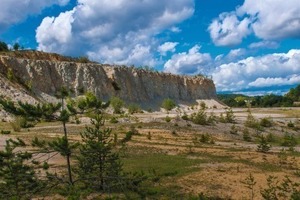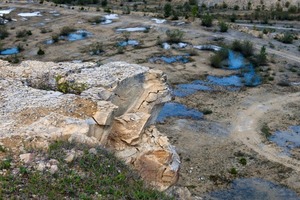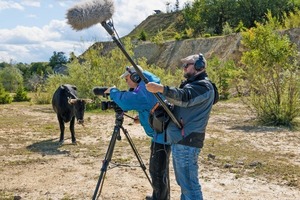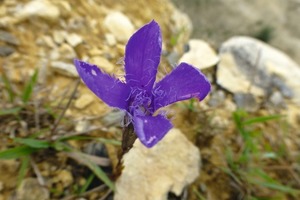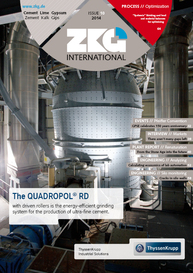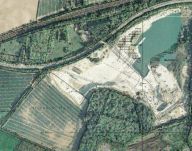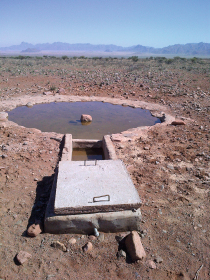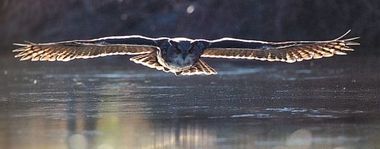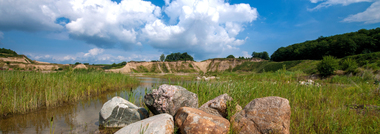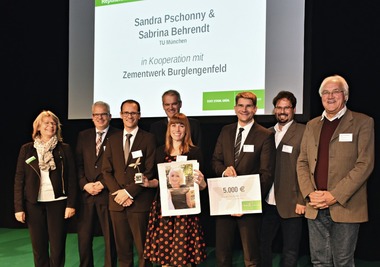From the Stone Age into the future –
film shooting in the quarry
The location: a quarry reminiscent of a wild, dried out alluvial floodplain (Fig. 1), with numerous small ponds sometimes also looking like a landscape in the Siberian tundra (Fig. 2). The protagonists: proud Taurus Cattle, a few mother cows with their calves and also some bulls that will soon become rivals (Fig. 3). These cattle, with their wild manes, impressive horns and a curious gaze, are the result of back-breeding to produce animals similar to the extinct aurochs.
However, the true background of this seemingly archaic scenery is entirely different: Responding to an invitation by HeidelbergCement, Professor Michael Succow, holder of the Alternative Nobel Prize, visited the grazing project in the Gerhausen quarry of the Schelklingen cement plant. He was accompanied by a film team under the leadership of documentary filmer Dieter Schumann. Also on the set: a shy, but interested herd of wild Konik horses with their dun coats and dark manes.
But the actual stars – eight different species of orchids and various species of gentian – are not immediately visible to the eye. However, when conservationist Michael Succow and Dr. Michael Rademacher, Manager of Biodiversity and Natural Resources at HeidelbergCement (HC) – both of whom are passionate biologists – kneel down and peer at the barren ground, one thing is sure: that they have spotted a rare plant.
In fact, what they have found is a specimen of Gentianella germanica (Fig. 4), known in English as the “Chiltern Gentian”. This fact that this little gem, which died out long ago at many other locations, flourishes on the meagre soil of this quarry in the Swabian Alb region is due to two things: the open, karstic terrain left behind by the quarrying of limestone, and the constant grazing by the two species of large animal. For years now, the cattle and horses have efficiently prevented bushes and trees from covering the raw soil and overgrowing the nutrient-poor grassland which is so uncommon these days.
Just as their forebears did thousands of years ago, the animals roam over the 75-hectare area. In a manner of speaking, they are quite at home in this Southern German region, even if they were re-introduced just a short time ago. Important archaeological discoveries in the nearby caves of “Hohler Fels” near the town of Schelklingen prove that their ancestors were hunted by stone-age people. For many years now, the Schelklingen cement plant, which is located in the direct neighbourhood of the caves, financially supports the excavations being carried out there, which are producing results comparable with those of the internationally renowned caves of Altamira in North Spain or the Lascaux caves in the Dordogne region of south-western France. This commitment has been rewarded by the joy felt about the discovery of items of prehistoric sculpture, such as an ivory water bird, the human-lion hybrid figure, or more recently the “Venus of Hohlefels” near Schelklingen, a 6-cm-large statuette of a woman that is at least 35 000 years old. It was found in 2008 and is one of the world’s earliest examples of figurative art.
HC plant manager Hans Georg Kraut is enthusiastic and very knowledgeable about the wild animals grazing the disused quarry. Right from the outset, he has been closely involved in the project co-financed by his company. “The project fits excellently into our company’s sustainability strategy, with its aim of promoting biological diversity”, he explains, “and it is simultaneously a showcase project representing the cooperation between HeidelbergCement and BirdLife International.”
The German partner of BirdLife International is Naturschutzbund Deutschland (NABU), which explains the presence of Matthias Strobl on the day the film was made. Strobl is the agriculture expert of NABU Baden-Württemberg, and – thanks to the cooperation agreement with HC – he has the task of looking after the project. Right from the beginning, his organisation and the Industry Association of Industrial Minerals and Aggregates “Steine und Erden” (ISTE) have been partners and advisors for the nationally unique grazing project.
Strobl succinctly expresses what in the broadest sense can be described as a paradigm shift, and represents a changed attitude to nature conservation and to the cooperation partner of the Schelklingen project. “Why shouldn’t an industry association be actively committed to nature conservation?”, he asks. “The possible spectrum of commitment is very broad – starting with renaturation and conservation on company land, and ranging through setting good examples to employees right up to playing a pioneering role in the industry and thus encouraging competitors to take similar actions.” This means that black-and-white attitudes in nature conservation – on the one side the good environmentalists and on the other side the destructive industrialists – will become obsolete; at the latest when future-oriented companies become aware of their responsibility for sustainability and actively implement this principle in their corporate policy. In Strobl’s opinion, both sides profit from this change in attitudes.
For HeidelbergCement, quarry renaturation is far more than an ecological fig leaf. As a global player with over 800 quarries worldwide, HeidelbergCement implements its strict rules regarding sustainability on all continents of the earth. The man-made biotopes, so-called secondary biotopes, created by the company are in accord with a modern mode of nature conservation thinking, which recognises that unused fallow land is a blessing for nature in an environment that is increasingly regulated by human activities.
The documentary film planned by HeidelbergCement concentrates on the grazing project in the Gerhausen quarry and the work of a nature conservation foundation at the HC location in Geseke near Paderborn in eastern North Rhine-Westphalia. According to Dr. Rademacher, the company wishes to document “how sustainable recultivation functions. Today, our approach is more strongly directed at sustainable location management and at showing the value brought by a cement plant to the local community.”
“People have to learn how to love nature again”, says Professor Succow, who sees the dramatic loss of biological diversity and the declining functional capability of ecosystems as a main problem of the global crisis. The documentary film project, which is also explicitly aimed at the coming generation, is intended as a means of showing the beauty of nature, but also the relentless pressure that nature is facing. Young people can also learn the value of natural biotopes via the medium of film. Succow places faith in the Mephistopheles principle that self-interest can bring forth what do-gooders have been long campaigning for, mostly in vain: social and ecological responsibility.
To this end, Succow has been creating alliances of good sense all around the world, which includes setting large areas of land aside for nature to take its course. He is no longer wary of cooperating with industrial concerns, as long as they are serious in their commitment to conservation. Although he shares the critical view of Jane Goodall, the renowned conservation activist, who in an interview accused some companies of “green-washing” themselves, he says that he is certain that: “HeidelbergCement is not green-washing itself. I have met people who are participating in the renaturation of HC quarries in many parts of the world, and I have seen photos that document this work. And I was deeply impressed”.
//www.heidelbergcement.com" target="_blank" >www.heidelbergcement.com:www.heidelbergcement.com

